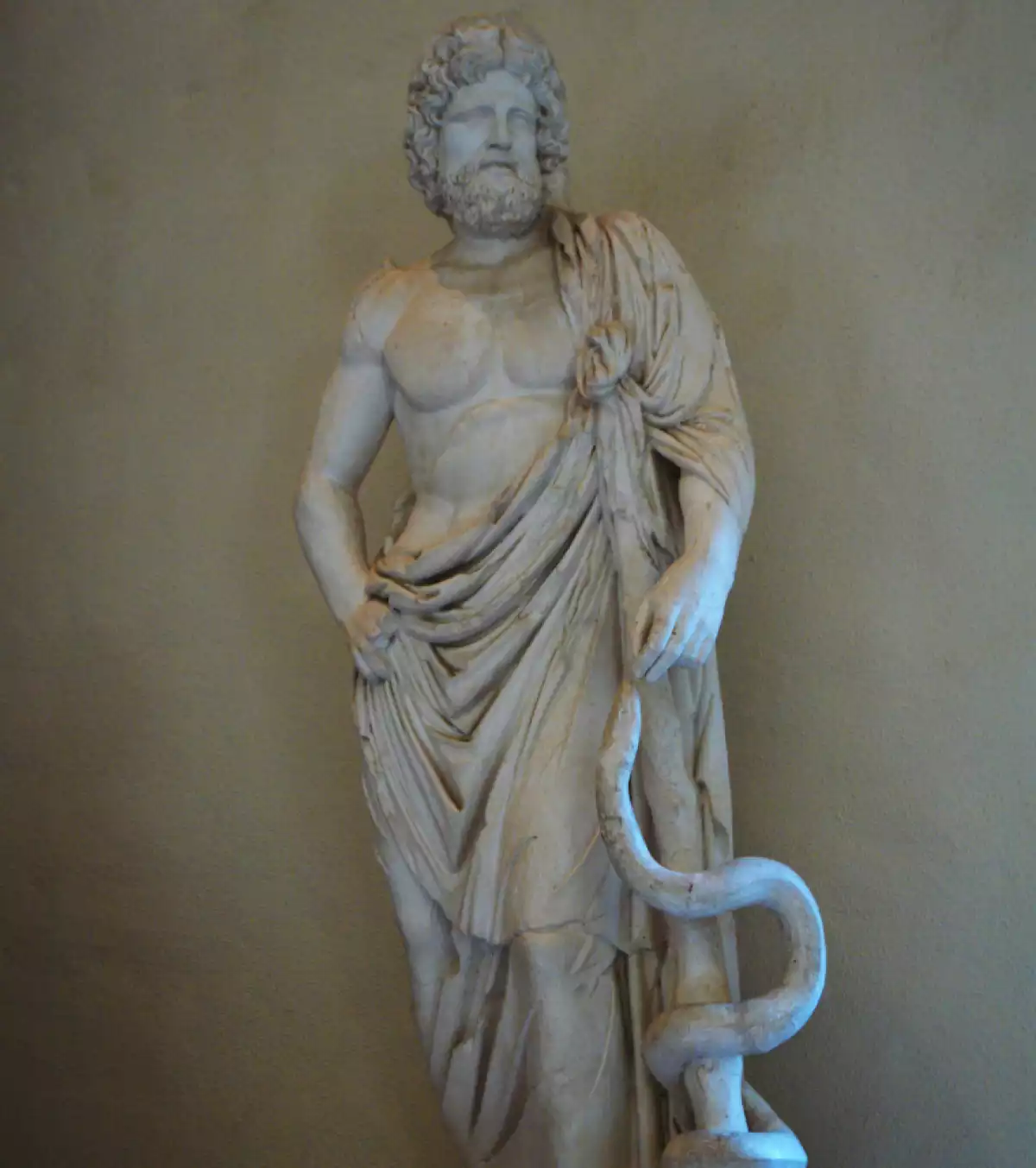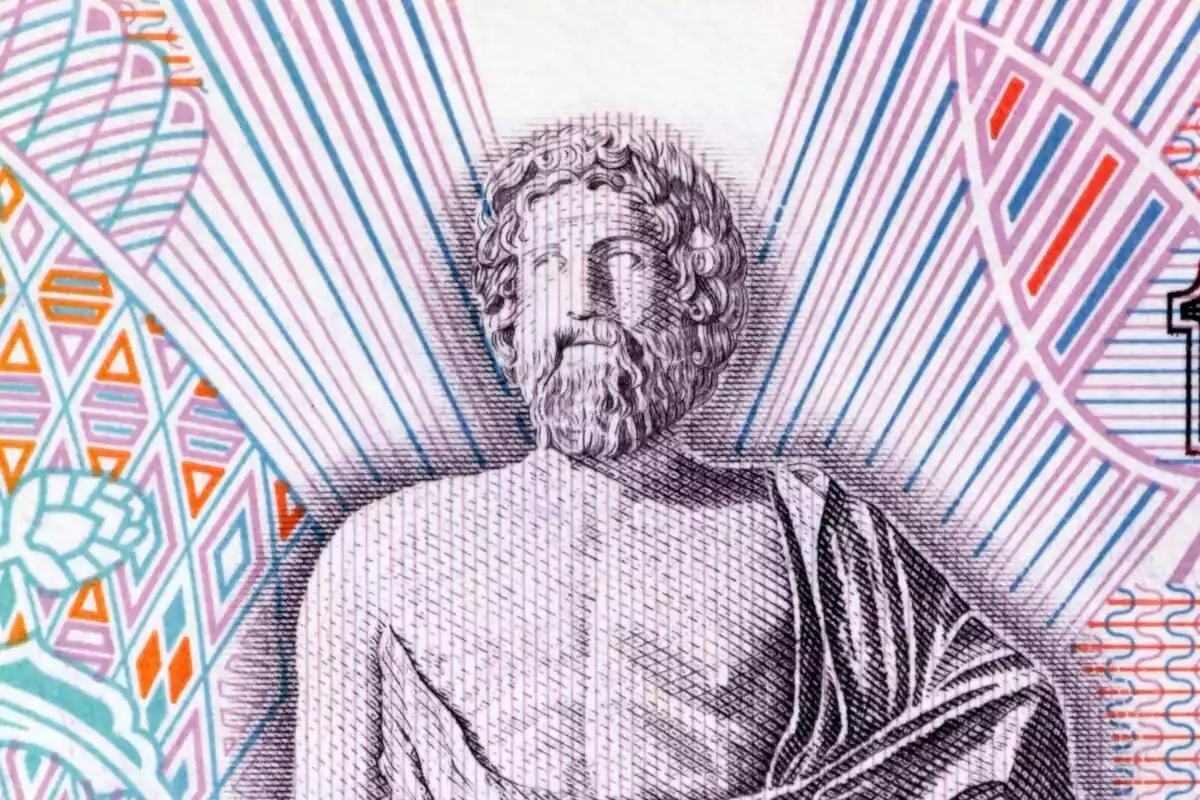The rod of Asclepius is the universal symbol of medicine and everyone across the world recognizes the serpent-entwined staff that was wielded by the Greek god Asclepius, a deity associated with healing and medicine. This article aims to summarize the history of Asclepius, his main contribution to the Greek myths, and his connection to the constellation Ophiuchus ("the Serpent Holder").
Asclepius - God of medicine
In ancient Greece, approximately between centuries 5 bc. and 1 ad., Asclepius or Asklepios, was worshiped as the god of medicine. Many temples were erected in his honor, called Asclepeions, and the most famous one was in Trikki, in the northeast of Greece. It comes as no surprise that ancient Roman culture was vastly influenced by Greek culture and the god of medicine is an excellent example of this.
The Greek Asclepius was to be found in the Roman pantheon bearing the name of Aesculapius and displaying all the characteristics of his Greek counterpart. Asclepius' influence on modern medicine remains visible to this day, immortalized in the first sentence of the Hippocratic oath, a Greek medical text written in the 3rd-century bc., that references Asclepius and his daughters Hygieia ( she was the goddess of health, cleanliness, and hygiene) and Panacea ( the goddess of universal remedy.)
"I swear by Apollo Physician, by Asclepius, by Hygieia, by Panacea, and by all the gods and goddesses, making them my witnesses, that I will carry out, according to my ability and judgment, this oath and this indenture."
Moreover, milkweed or Asclepias is a genus of herbaceous, perennial, flowering plants that carry the god's name.

According to Greek mythology, Asclepius was the son of Apollo, god of arts and associated with medicine, and a mortal woman names Coronis. After Coronis' death (as punishment for adultery or during labor, depending on the version of the story) Apollo rescued his newborn son and carried the baby to the centaur Chiron. Asclepius was instructed in the art of medicine by the centaur, and in a short period, he surpassed the healing powers of both his master and his father.
The character of Chiron appears in many Greek legends (Achilles, Hercules, Ulises, Perseus) and he was called the "wisest and justest of all the centaurs." The Greek god was married to Epione, the goddess of soothing of pain, with whom he had five daughters: Hygieia, Panacea, Aceso, Iaso, and Aglaea, and three sons: Machaon, Podaleirios, and Telesphoros. He also had another son, Aratus, with Aristodama, a poet of ancient Ionia.
The legend tells the story of an ever powerful Asclepius, whose resurrecting abilities began to interfere with the population of earth. Asklepios was able to bring back the dead which upset Zeus, as there were too many people walking the planet, which resulted in Zeus killing Asclepius with a thunderbolt. After Asclepius's death, Zeus placed his body among the stars in the constellation Ophiuchus ("the Serpent Holder").

Rod of Asclepius - Symbol of medicine
The Rod of Asclepius also known as the Staff of Asclepius (sometimes also spelled Asklepios or Aesculapius) and as the asklepian, is a serpent-entwined rod wielded by the Greek god Asclepius, a deity associated with healing and medicine.
The history of The Rod of Asclepius dates back to ancient times when the snake and the staff were used as individual symbols for medicine. One of the myths associated with the god of medicine tells the story of how in honor of Asclepius, a particular type of non-venomous snake was often used in healing rituals, and these snakes – the Aesculapian snakes – crawled around freely on the floor in dormitories where the sick and injured slept.
These snakes were introduced at the founding of each new temple of Asclepius throughout the classical world. From about 300 BCE onwards, the cult of Asclepius grew very popular, and pilgrims flocked to his healing temples (Asclepieia) to be cured of their ills. The serpent has been used as a symbol of medicine as it refers to the regenerative abilities of these skin shedding animals. Along with the snake's venomous properties, it is believed that the serpent represents both illness and treatment at the same time.
On the other hand, the staff itself could be associated with traveling doctors who used a long rod, or a staff, on their long distance walks. According to Greek philosopher Cornutus, The Rod of Asclepius stresses the importance of support for one's health. (Edelstein y Edelstein, 1998).
The Staff of Asclepius is frequently confused with the staff of the god Hermes, the caduceus - which depicts a short staff entwined by two serpents surmounted by wings. Hermes' staff has very little to do with medicine, as it is an icon of commerce, eloquence, negotiation, alchemy, wisdom, and controversially, thievery, lying, and the passage into the underworld.

Other medicine and health deities
In Egyptian mythology, Sekhmet is a warrior goddess as well as the goddess of healing. She is depicted as a lioness, the fiercest hunter known to the Egyptians, and the one who cured goddess Isis, a high ranking deity associated with birth, death, maternity, magic, and wisdom among others. In Norse mythology, we have the goddess Eir, associated with healing. She is known to be one of the handmaidens of Frigg, who is the wife of Odin, the king of the gods (there are many mentions of this in the Poetic Edda, a book of Old Norse anonymous poems.)
In Celtic mythology, Airmid, also known as Airmed or Airmeith, is the goddess of the healing arts whose main job was healing the wounded soldiers that fell in battle. According to Celtic legends, all the natural remedies on Earth were created when Airmid's brother died. When the grieving Airmid went to visit her brother’s grave, she suddenly saw hundreds of plants growing up among the flowers there, and the goddess’ tears watered all the herbs of the earth and created healing plants.
The African Yoruba people talked of a spirit or orisha called Aja. This health deity was described as the protective spirit of forest animals, master of healing potions, and botany. According to the African myth, it was Aja that passed on all the knowledge that the Yoruba people now hold.
Check out the original article: Asclepio (Esculapio), dios griego de la salud y portador de la serpiente enroscada at viviendolasalud.com
References:
Edelstein, L. & Edelstein, E. (1998). Asclepius: A collection and interpretation of the testimonies. Johns Hopkins Press.
Wickkiser, B. (2008). Asklepios, medicine, and the politics of healing in fifth-century Greece: Between craft and cult. Johns Hopkins Press.
Wilcox, R. A. & Whitham, E. M. (2003). The symbol of modern medicine: why one snake is more than two. Annals of Internal Medicine, 138: 673-677.
